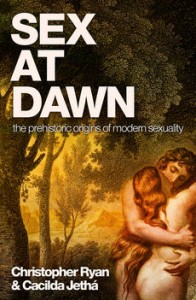 According to Christopher Ryan and Cacilda Jethá, authors of Sex at Dawn: The Prehistoric Origins of Modern Sexuality (2010), and a psychologist and practicing psychiatrist, respectively, men and women aren’t meant to be in lifelong monogamous unions. In their attempt to explain the high divorce rates in the western world, they argue that monogamy is in direct confrontation with the evolved reality of our species.
According to Christopher Ryan and Cacilda Jethá, authors of Sex at Dawn: The Prehistoric Origins of Modern Sexuality (2010), and a psychologist and practicing psychiatrist, respectively, men and women aren’t meant to be in lifelong monogamous unions. In their attempt to explain the high divorce rates in the western world, they argue that monogamy is in direct confrontation with the evolved reality of our species.
* * *
Drawing from studies of human physiology, archaeology, primate biology and anthropological studies of pre-agricultural tribes from across the globe, they argue that monogamy and the nuclear family are more recent inventions, and “less natural” than most of us would expect.
Before the advent of agriculture, they argue, prehistoric humans lived in a much less sexually possessive culture. Among the foraging groups where most things (food, childcare, shelter and defense) were shared, it made sense that sexuality was also shared. With the advent of agriculture and the consequent concern with property ownership and the wish to bequeath that property to one’s own child, paternity became an issue.
The authors point out that the peaceable bonobo, closely related to the human, actually have more in common with humans in terms of “socio-sexual behavior and infant development” than do chimps. The libidinous bonobos, however, are routinely ignored by researchers, “simply because bonobos raise doubts about the naturalness of human long-term pair bonding.”
They suggest, too, that the fact that human testicles are not as small relative to our body as the monogamous gibbon or gorillas reinforces their claim that monogamy is a new and recent development in our evolution.
Many critics challenge the book’s conclusions. Some argue that the authors have simply simplified the research others have done and have selectively quoted writers without fully engaging in their arguments (or citing their sources). Others claim to be fundamentally suspicious of applying anthropological and biological evidence to what are essentially moral and ethical concerns. Still others point out that people throughout history have varied widely in their preferences, and that what is normal/abnormal or natural/unnatural differs from subculture to subculture.
Whether or not we agree with the authors’ premise that love and sex have not always and do not “naturally” or necessarily go together, we can perhaps agree on pursuing a more tolerant and more realistic understanding of the diversity of human sexuality.